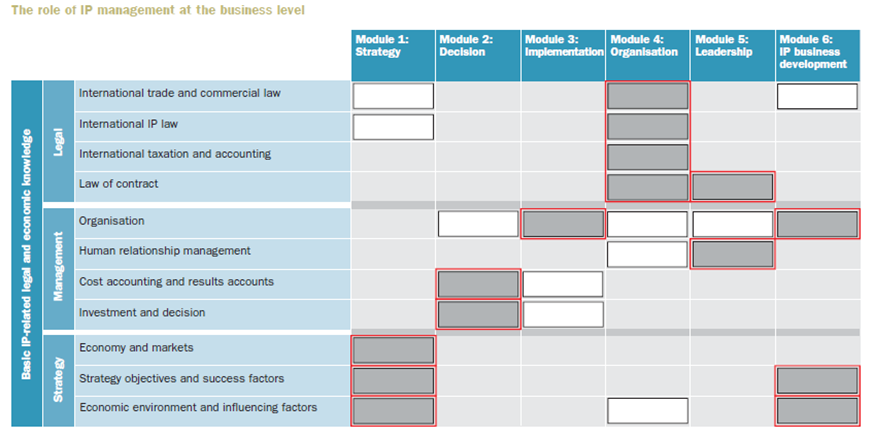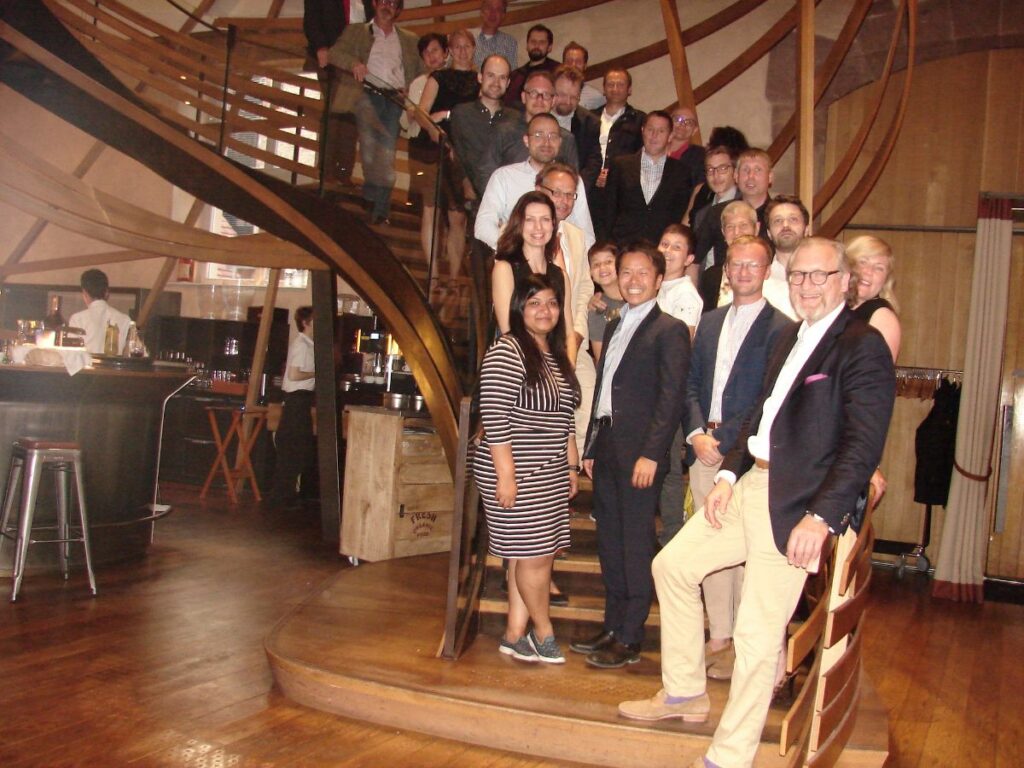15 Years of MIPLM method
a continuous success story
Dr. Alexander Wurzer is Professor of IP Management at the University of Strasbourg at the Supranational Institute for Research and Training in Intellectual Property. He founded the Master’s degree in IP Management and has been its director since 2008.
Since 2019, Prof. Wurzer has also been in charge of the university diploma course in IP Business Administration, which is successfully carried out worldwide as fully digitized distance learning. The courses are carried out jointly with the European Patent Office and the academic degrees are awarded jointly with the EPO. He works with lecturers from all IP5 countries: USA, Japan, Korea and China in his courses.

The planning and the concept
The unique success of the Master’s program in IP Management at the Center for Intellectual Property Studies (CEIPI) of the University of Strasbourg is based on the MIPLM method. For 15 years, this method has combined various learning elements, such as lectures for the sound transfer of theoretical-empirical knowledge, with practical case studies and the use of guidelines, which can now be used interactively by students via a digital learning platform. This combination makes the interdisciplinary learning experience as practice-oriented as it is particularly valuable and sustainable. Graduates are thus enabled to put successful IP management into practice in their national innovation systems, organizations, companies, and as lawyers and consultants.
The development of the MIPLM method to teach IP Management goes back to the design of a then completely new degree program: CEIPI Master for Intellectual Property Law and Management (MIPLM). Discussions on this began back in 2005 between the then CEIPI General Director Prof. Yves Reboul, who resigned from his position as Director of the French Section at CEIPI in an honorary ceremony on October 17, Benoit Battistelli (President of the European Patent Office and President of the Admininstrative Board of CEIPI) and Dr. Alexander Wurzer, Director of the Steinbeis Institute for IP Management at Steinbeis University Berlin.
Already in the first conceptual phases for the creation of the Master’s program, it was clear that new territory would be entered. A teaching method should be developed from the outset that meets the special requirements of IP management training:
- Provide an interdisciplinary theoretical foundation
- Continuous updating and adaptation to the respective world-wide industrial practice
- Consideration of academic and practically oriented experts and their teaching content for a consistent learning experience by the participants
- Consideration of time availability in the context of parallel teaching schedules and practical activities in the professional everyday life
- High practical relevance of the knowledge with the use of the latest tools for the concrete implementation in the operational and organizational reality
In a total of four publications, the considerations, and conceptual approaches for the design of this study program were presented to the professional public for discussion. The first publication in 2006 by Alexander Wurzer and Roya Ghafele, then Economist at WIPO, deals with the question of how the intrinsic interdisciplinarity in IP management could be captured in an academic education, under the title “The clash of mindsets”:
“In or to capture the full value of intellectual property a new generation of IP professionals needs to arise: people who think and act in an interdisciplinary way, and define value from a business, legal and technical perspective.
The fundamental problem, that IP managers must ultimately be able to combine very different perspectives, was clear from the outset:

Here you can download the paper: https://www.iam-media.com/article/the-clash-of-mindsets
In the following publication from Roya Ghafele, WIPO, Yves Reboul, CEIPI – University Strasbourg, Stefan Hundertmark and Alexander Wurzer, both from Steinbeis University, in the same year, the whole concept of the master education in IP management at CEIPI was presented to the professional public in the paper: “Rethink IP education”:
“Further interdisciplinary training on IP management is vital if the full potential in IP rights is to be realised. What is needed is a master’s programme that would help to overcome current educational shortcomings”.
Here you can download the paper:
https://www.iam-media.com/article/its-time-rethink-ip-education
This publication has already presented the entire interdisciplinary and practice-oriented concept of the new Master’s Program in IP Management.

From the beginning in 2006 it was a clear commitment to content orientated success factors:
1 . Prepare participants to meet the challenges of high-level IP management.
2 . Build up IP professionals who can operate at firm level and as independent experts.
3 . Ensure an unrestricted flow of continuously updated teaching materials.
4 . Communicate empirical findings through an approach that is as praxis oriented as possible.
5 . Teach best practice IP management across various industries.
6 . Adopt a practical definition of IP management.
7 . Provide training materials that reflect academic and practical best practices.
The implementation and methodological superstructure
In 2006, the practical implementation of the new MIPLM methods was started and a first Master’s program took place at the Centre d’Etudes Internationales de la Propriété Intellectuell in the academic year 2006/07. Then, in 2008, the professorship of IP Management was created, and Prof. Dr. Alexander Wurzer was appointed co-director of the newly created program.
He gave his inaugural lecture on the occasion of a GRUR conference at CEIPI in Strasbourg and he published this lecture in GRUR under the title: “IP Management – Schlüsselkompentenzen in einer Wissensökonomie” GRUR 2008, issue 7 page 577- 586: The knowledge economy relies heavily on intellectual property as a key component. Companies can utilize intellectual property to generate profits by employing focused appropriation strategies and investing in new knowledge. To achieve this, interdisciplinary collaboration between different subsystems of the knowledge economy is crucial. Effective IP management is necessary to optimize appropriation and requires a diverse range of skills and expertise. The management of intellectual property has led to the emergence of new competencies and capabilities in the knowledge economy. Understanding the mechanisms of IP exploitation and wealth generation in the knowledge economy highlights the need for novel approaches to training.
The knowledge economy refers to an economic system where the creation, dissemination, and application of knowledge and information are significant drivers of economic growth and development. It is a shift away from traditional industries, such as manufacturing and agriculture, towards industries that are centered around the creation and management of knowledge, such as information technology, biotechnology, and other knowledge-intensive sectors.
In the knowledge economy, the focus is on the value of knowledge, ideas, and innovation as opposed to physical goods or services. Companies and organizations in the knowledge economy rely heavily on the intellectual capital of their employees, as well as investments in research and development to generate new knowledge, products, and services.
The knowledge economy is driven by factors such as globalization, technological advancements, and the increasing importance of intangible assets, such as patents, copyrights, and trademarks. The knowledge economy requires a highly educated workforce, specialized skills and expertise, and a strong emphasis on innovation and creativity.
With this paper from 2008, the intellectual superstructure for the IP management education at CEIPI was explained in the context of the MIPLM as a manifest and was subsequently implemented in the course. The worldwide success of this course proves the creators right, that there was a need in the emerging knowledge economy for this qualification and that it could be satisfied.
The implementation and successes
The continued success of the MIPLM methodology since 2008 has attracted the attention of national and regional institutions around the world, who have been looking for ways to collaborate:
- WIPO-CNIPA (China): WIPO-CNIPA Advanced Training Course on Management and Commercialization of Intellectual Property Assets 17.-28.10.2022 – IP Business Academy
- INAPI (Chile): Webinar of CEIPI and INAPI: IP Protection of Digital Use Cases and Gamification – IP Business Academy
- NIPMO (South Africa): Follow-up to the NIPMO Colloquium: Driving innovation and positioning Intellectual Property commercialisation for a better and inclusive South Africa at 23-24.02.2022 – IP Business Academy
Lecturers from all over the world have been integrated as lecturers and content creators for the learning platform:
- Interview with Constanza Miller: Interview with Constanza Miller about awareness building for IP – IP Business Academy
- List of lecturers and content creators: Lecturers | Experts | Content Creators – IP Business Academy
Industry examples from various industries were integrated into the learning platform to give students the opportunity to learn from these practical examples.
- Signify (Netherlands): Did they really patent this use case? Signify, the meaning of light – IP Business Academy
- Lego (Denmark): Did they really patent this use case? – The Lego eco-system – IP Business Academy
- Streaming industry: Did they really patent this use case? – Example: Streaming industry – IP Business Academy
A case study program was developed:
- Link to the case study program: University Industry Case Studies – IP Business Academy
A separate university diploma for Business Administration was created as a pure distance program to meet the worldwide demand for IP management education:
- Link to the diploma program: Diplôme Universitaire IP Business Administration (DU IPBA) – IP Business Academy
An open foresight project ensures that the latest developments in IP/IP management are taken into account in the training courses:
- Link to the open foresight program: Open Foresight Program – IP Business Academy
For graduates of the programs:
- Link to our graduate program: Phd | Master | Research Projects on IP-Management at CEIPI – IP Business Academy
an extensive alumni support program is available:
- Link to I3PM: About – I3PM
Various case studies have won awards:
- Winners of the German Innovation Award: Four German Innovation Awards for IP-Design case studies in 2020 – IP Business Academy
As well as graduates have been awarded and immediately heard in the regional innovation systems:
- Catalina Olivos – Winner of the INPI Start-up award 2021: Alumna Portrait: Catalina Olivos on IP strategy applied in practice – IP Business Academy
The MIPLM method in detail
At its core, the MIPLM methodology is based on four elements that are connected via a digital cloud-based content portal:
- Slide decks for didactic preparation of the content with access to the original sources, studies, publications as well as video material such as interviews and explanatory videos.
- Case studies from worldwide business practice from different industries, value chains or business eco-systems, company sizes with different challenges for practical application of the content.
- Step-by-step solution guides with sample solutions and AI-based support for finding solutions
- Content portal that connects the different elements and is available 24/7 worldwide and is continuously updated regarding all learning resources including the glossary, industry cases and literature access.

This combination leads to very sustainable learning experiences that go far beyond the passive reception of slide presentations. Students are directly exposed to the material through original publications, interviews and educational films. The step-by-step execution of the case studies makes it easy to monitor individual learning progress and provide assistance with any questions that may arise. In this way, students develop their own problem-solving skills based on a deeper understanding of the theoretical content. The connection to the latest industry developments shows the high practical relevance of what has been learned and creates additional motivation to deal with the topics in an appropriate learning depth for one’s own competence development.
Here are some examples of the success of this method:
Design Driven Innovation: RITTAL
Organizational Implementation of a Patent Strategy: Vorwerk Thermomix



